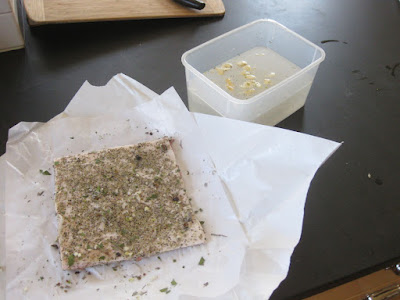Much of what you eat in charcuterie is fat, whether it is marbled in to a whole muscle like coppa or ground up in chunks of various size in a cured sausage like sopressata. Since becoming interested in this pursuit I had read about straight up cured fat, or lardo. Like the average american I was a little intimidated by this concept, but Becky is more intrepid than I when it comes to weird meat and fat eating and thought it sounded promising.
There are various ways to make lardo, according to different traditions and ingredients one has on hand, but I thought I would try out an all salt cure. The highest expression of this approach is Lardo di Colonnata, which is lovingly cured in special garlic rubbed white marble basins in a small town in the Italian alps. This sounds more romantic than sitting in a tupperware in my basement! As in most of these things, I had no illusions that my product would be up to the artistic pinnacle of the IGP Italian lardo, but even so I was hoping it would be good to eat and fun to make.
In the context of straight razor making I was virtually introduced by my friend JD to a guy in Philadelphia named Tony Gatta, who was generous enough to tell me how he and his wife cure their lardo. I mostly followed his guidelines.
I picked up a ~500g piece of fat cap from a shoulder at my neighborhood butcher.
We prepared the brine in a tupperware, rubbed the spices into the fat, then plopped it in the bath. We used:
- 1500ml water
- 450g kosher salt
- ~6 garlic cloves, chopped in half
- a few crushed juniper berries
- a few bay leaves
- dried sage
Of course the fat floats.
So I dropped on a couple chunks of spare bianco carrera marble I had around (another idea from Tony). This is amusing when thought of as a vestigial nod to the mystical marble lard coffins of Colonnata. I closed up the tupperware and stuck it on a shelf in the cellar for about 10 weeks.
The bath had darkened considerably after its lengthy brewing period.
The fat was stiff and smaller in volume than before; pretty much what you expect from meat that has been cured.
After retrieval from the bath, I rinsed it off in the sink and patted it dry.
Then I let it dry on a rack in the fridge overnight. Of course the fat is extremely salty at this point, which served to corrode the rack it was on at places where there are defects or pinholes in the plating. So there was some discoloration on the bottom side in some spots. Stainless in future!
I sliced a few pieces and tasted it. Pretty good; very much a cured pork flavor, and extremely rich and salty. I tried some on a piece of fresh baked french bread, which was nice. I think it could fill the same culinary niche as butter. It is a bit stringy; maybe I'm not cutting it thin enough or perhaps this tendency would be reduced by using fat from a different part of the porcine anatomy. Not being the world's most enthusiastic lover of charcuterie, in most cases I'd probably prefer to just use butter. I would however like to taste some professionally done (or talented amateur made) lardo to see how far it exceeds my humble product.









3 comments:
Lardo sounds fabulous! (I love my fat) Do you think this might be better done in glass rather than plastic, since plastic can leach?
Oh, I'm sure that would be an improvement. Honestly I didn't think of that, though I'm not sure I could have rolled up that fat tight enough to fit through the hole of a 2L mason jar. If only I had a garlic rubbed marble fat curing box!
These tupperwares are ancient, so I think any leftover plasticizers in there have long since leached into food eaten in the past. But its true that it is an extraordinary opportunity for leaching, with the weeks long curing in liquid contact with the plastic.
Wish I hadn't been reading this in early morning-somehow I would need to be desperately hungry to be involved in this food attempt or not see it in progress.Lol! When I was a young teacher a rural child brought popcorn as a snack for a party which was the best I ever tasted. When I wanted to know how it was done- I was told lard was used instead of oil to make it.So I do have to admit that popcorn was tasty cooked using lard. I would have skipped the popcorn tasting if I had known. I just can't get past the pig fat though. In the south lots of it get sneaked into the veggies as bacon seasoning so don't know why I am being so resistant to your experiment. Real butter is a lot nicer to make and eat in my thought bank but if the pig fat works for your family who am I to say nay. Lol! I don't have italian in the blood line as far as I know so can't speak of their pork use. In the south there used to be a lot of meat curing and smoking to preserve so don't know why I can't wrap my head around this post.I'll have a hard time with the soaking for weeks of a slab of fat in tupperware.Really glad to watch this experiment from afar. Sorry.
Post a Comment